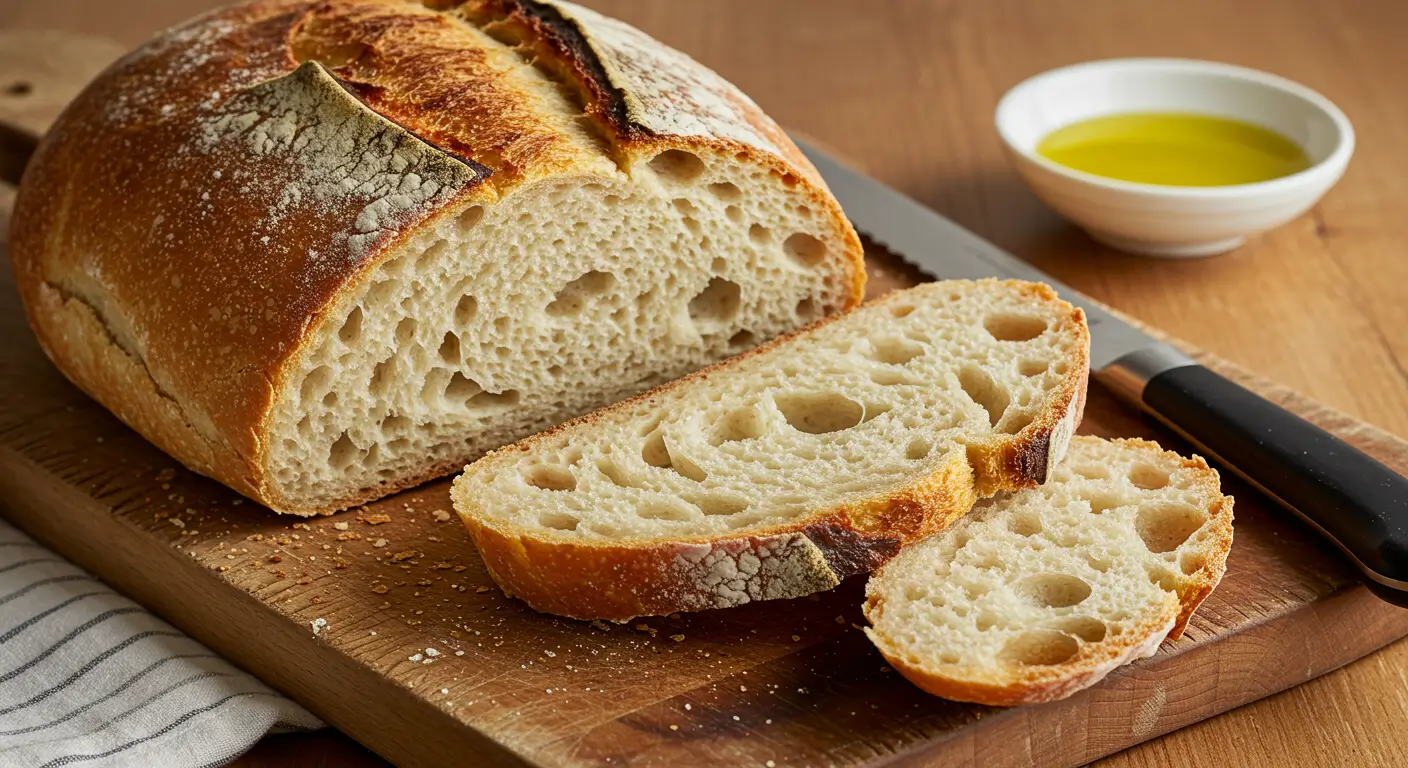Bastone bread is a classic Italian loaf with a crisp crust and soft, airy crumb. Its rustic texture makes it perfect for sandwiches, dipping, or enjoying on its own. This easy homemade recipe gives you bakery-quality results with simple ingredients. Whether you’re a beginner or an experienced baker, you’ll love the rich flavor and satisfying crunch of this artisan-style bread.
Why We Love This bastone bread
Bastone bread is the perfect balance of crisp crust and soft, airy crumb, making it a must-have for any home baker. This rustic Italian loaf is easy to make with just a few simple ingredients, yet it delivers bakery-quality results.
- Versatile & Delicious – Enjoy it fresh, toasted, or paired with soups, salads, and pasta dishes.
- Simple Ingredients, Big Flavor – A classic mix of flour, yeast, water, and salt creates an incredible depth of flavor.

- Beginner-Friendly – With step-by-step guidance, even novice bakers can achieve a beautifully golden, artisan-style loaf.
- No Special Equipment Needed – A baking sheet or stone is all you need to create this crusty, chewy bread at home.
Whether you’re making a hearty sandwich or serving it alongside your favorite meal, this homemade bastone bread is always a satisfying choice!
Ingredients for bastone bread
Bread flour – Using bread flour in Bastone bread ensures a chewy texture and great rise. Substituting with all-purpose flour can result in a softer, less airy bread.
Active dry yeast – This is the key leavening agent that helps the dough rise and achieve a light, airy crumb. Fresh yeast ensures the best results.
Salt – Salt enhances flavor and strengthens the gluten structure of the dough, but too much can negatively affect the yeast’s activity.
Olive oil – Adds moisture and flavor while keeping the Bastone bread soft and fresh with a slight richness.
Instructions
Making bastone bread is a rewarding process, and with these simple steps, you’ll have a beautiful loaf in no time. Follow along, and don’t forget to enjoy the process!
Activate the yeast – In a small bowl, mix warm water and yeast. Let it sit for 5 minutes until frothy.
Mix the dough – In a large bowl, combine bread flour and salt. Add the activated yeast mixture and olive oil, stirring until the dough forms.
Knead the dough – Transfer the dough to a floured surface and knead for 8-10 minutes until smooth and elastic, or use a stand mixer with a dough hook.
First rise – Place the dough in a lightly oiled bowl, cover it with a damp towel, and let it rise for 1-2 hours until it doubles in size.
Shape the loaf – Punch down the dough, then shape it into a long, oval loaf (bastone shape).
Second rise – Place the shaped dough on a parchment-lined baking sheet, cover it, and let it rise for 30 minutes.
Preheat the oven – Preheat your oven to 450°F (230°C) while the dough rises.
Score the bread – Once risen, use a sharp knife to make a few diagonal slashes on top of the dough to help it expand evenly during baking.
Bake – Place the dough in the preheated oven and bake for 25-30 minutes or until it is golden brown and hollow when tapped.
Cool – Let the bread cool on a wire rack before slicing.
Enjoy the satisfaction of freshly baked bastone bread, perfect for any occasion!
Pro Tips
To make your bastone bread even more incredible, here are a few helpful tips that will elevate your baking game and ensure the perfect loaf every time.
Use bread flour – Bread flour contains more gluten than all-purpose flour, giving the loaf its chewy texture and helping it rise higher. If you don’t have bread flour, all-purpose flour will work too, but the result may be slightly less airy.
Perfect your kneading – Knead the dough for at least 8-10 minutes until it’s smooth and elastic. This step is key to developing the gluten structure and giving the bread its desired texture.
Proper proofing – Don’t rush the rise! Allow the dough to double in size during the first rise, which typically takes 1-2 hours. If you’re in a hurry, you can place the dough in a slightly warmer area to speed up the process.
Steam for a crispy crust – For an extra crispy exterior, place a shallow pan of water in the oven while baking the bread. The steam will help develop the golden, crackling crust we all love.
Score the dough – Scoring the top of the dough allows the bread to expand while baking. It also creates those beautiful slashes you see on artisan loaves.
Let it cool – As tempting as it is, let your bread cool on a wire rack before slicing. This prevents the inside from becoming too soggy and lets the flavors fully develop.
With these simple tips, you’ll be well on your way to baking perfect bastone bread that’s just as good as any bakery loaf!
Variations
While the classic bastone bread is delicious on its own, it’s easy to get creative with some fun variations. Here are a few ideas to add your personal touch to this rustic loaf:
Herb-infused Bastone – Add 1-2 tablespoons of fresh rosemary, thyme, or oregano to the dough for an aromatic twist. The herbs will infuse the bread with flavor, making it perfect for pairing with soups and stews.
Garlic & Olive Oil – For a savory variation, finely chop 2-3 cloves and mix them into the dough, along with an extra tablespoon of olive oil. This will create a fragrant, garlic-flavored loaf that’s perfect for dipping in your favorite olive oil or balsamic vinegar.
Cheese Bastone – Mix 1/2 cup of shredded Parmesan or mozzarella into the dough for a cheesy, melt-in-your-mouth treat. The cheese will melt into the bread, adding both flavor and a rich texture.
Whole Wheat Bastone – For a heartier, healthier version, substitute half of the bread flour with whole wheat flour. This will give the bread a denser texture and a slightly nuttier flavor while still maintaining the same rustic charm.
Sweet Bastone – If you’re craving a sweeter variation, add 1/4 cup of sugar and 1 teaspoon of cinnamon to the dough. This works beautifully for breakfast or as a side to your favorite jams and spreads.
Feel free to experiment with these variations or even come up with your own! Each twist will give your bastone bread a unique flavor and make it even more enjoyable.
Serving Suggestions
Here are a few delicious ways to enjoy your Bastone bread:
For Breakfast, Toast slices of bastone bread and spread with butter, jam, or peanut butter for a simple, satisfying breakfast. The crusty exterior and soft interior make it the perfect base for your morning spread.
With Soup – Bastone bread is fantastic when paired with hearty soups like tomato soup or vegetable stew. Tear off chunks to dip into the soup, soaking up the rich flavors.
With Olive Oil – Serve slices of bastone bread alongside a dish of olive oil for dipping. You can drizzle the bread with a little balsamic vinegar and sprinkle it with sea salt to enhance the flavor.
These simple pairings let the rustic, fresh flavor of bastone bread shine and bring extra comfort to your meals.
More Bread recipes you will love!
FAQs
Here are answers to some commonly asked questions about bastone bread to help you get the best results every time:
What kind of bread is bastone?
Bastone bread is a rustic, Italian-style loaf known for its crispy crust and soft, airy interior. It’s a simple yet delicious bread that’s perfect for serving with soups and stews or as a base for sandwiches.
How do I store bastone bread?
To keep your bastone bread fresh, store it in a paper bag or a breadbox at room temperature for up to 2-3 days. If you want to keep it longer, wrap it tightly in plastic wrap or foil and freeze it. Simply thaw at room temperature or reheat in the oven for a freshly baked taste.
Can I make bastone bread ahead of time?
Yes! You can prepare the dough the day before and let it rise in the refrigerator overnight. This will develop more flavor and make the bread even more delicious. Just let it come to room temperature before baking.

bastone bread
Ingredients
- 3 ½ cups bread flour
- 1 ½ teaspoons active dry yeast
- 1 ½ cups warm water 110°F
- 2 teaspoons salt
- 1 tablespoon olive oil
Instructions
- Activate the yeast – In a small bowl, combine the warm water and yeast. Let it sit for 5 minutes or until it becomes frothy.
- Mix the dough – In a large mixing bowl, add the bread flour and salt. Pour in the activated yeast mixture and olive oil, then stir until a dough forms.
- Knead the dough – Transfer the dough to a floured surface and knead for about 8-10 minutes until the dough is smooth and elastic. You can also use a stand mixer with a dough hook for this step.
- First rise – Place the dough in a lightly oiled bowl, cover it with a damp towel, and let it rise for 1-2 hours or until it doubles in size.
- Shape the loaf – Punch down the dough, then shape it into a long, oval loaf (or bastone shape).
- Second rise – Place the shaped dough on a parchment-lined baking sheet. Cover it again and let it rise for about 30 minutes.
- Preheat the oven – While the dough is rising, preheat your oven to 450°F (230°C).
- Score the bread – Once the dough has risen, use a sharp knife to make a few diagonal slashes on the top of the loaf. This helps the bread expand evenly while baking.
- Bake – Place the dough in the preheated oven and bake for 25-30 minutes or until the bread has a deep golden-brown crust and sounds hollow when tapped on the bottom.
- Cool – Let the bread cool on a wire rack before slicing.
Send me this recipe!
Just enter your email below and get it sent straight to your inbox!


